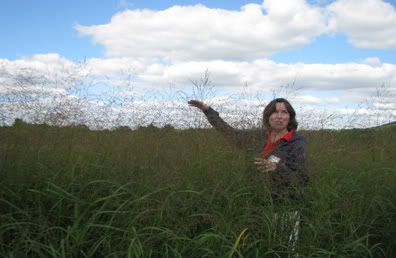Researchers identify field grasses that will fuel the bioenergy era

The College of Agriculture and Life Sciences' (CALS) Bioenergy Feedstock Project, now in its second year, is the only project of its kind devoted to exploring the many species of field grass that grow in the Northeast and their potential as sources for bioenergy products. Earlier research has shown that polycultures of 'low impact high diversity' grassland bioenergy systems can not only yield large amounts of biomass, but also increase biodiversity and sequester carbon in soils (previous post).
The project has roughly 80 acres of different warm- and cool-season perennial grass varieties, growing in 11 counties across New York. The researchers' ultimate goal is to maximize the economic benefit of bioenergy production as an alternative energy source, said Donald Viands, professor of plant breeding and genetics, who heads the project, speaking against a colorful backdrop of a field of blue, green, lavender and beige hues, where some plants were withering, but some were some thriving.

Hilary Mayton, extension associate and coordinator of the project, said that of the 12 varieties of switchgrass planted, some are showing a distinct advantage over others. Visitors saw how some strips of these warm-season grasses appeared stunted and unhealthy, while others were tall and vibrant. Julie Hansen, a Cornell plant breeding and genetics senior research associate, discussed trials on cool-season grasses, such as tall wheat grass and tall fescue, some of which are now commonly grown for feeding livestock:
 energy :: sustainability :: biomass :: bioenergy :: biofuels :: energy crops :: grass :: biodiversity :: soil carbon sequestration :: polycultures ::
energy :: sustainability :: biomass :: bioenergy :: biofuels :: energy crops :: grass :: biodiversity :: soil carbon sequestration :: polycultures :: When the small plots and strip trial demonstration grass trials are harvested later this year, Mayton and her Cornell and private company collaborators will obtain data for both gasification (heat, power and liquid fuels) and cellulosic conversion technologies (biofuels and other byproducts) from the different types of grasses.
In the wild, many of these native perennial grasses can survive, and even thrive, on marginal land. Some of the Cornell trials were specifically planted on land that is not suitable for such domesticated, monoculture food crops as corn.
Paul Salon, a plant material specialist with the Natural Resources Conservation Service of the U.S. Department of Agriculture who is working closely with Cornell on the project, noted that the close proximity of agricultural land to major population and transportation centers in the Northeast makes this region ideal for developing bioenergy crops and industrial byproducts, which is why so much is riding on these fields of mixed greens.
The project is funded by the New York Farm Viability Institute, CALS and the Cornell Agricultural Experiment Station.
Picture 1: Extension associate Hilary Mayton discusses the future of bioenergy in the Northeast in a field of switchgrass Sept. 10. Credit: Lauren Chambliss.
Picture 2: Cool-season perennial grass varieties have great potential for producing the quantity and quality of biomass needed for conversion to alternative, renewable energy. Credit: Lauren Chambliss.
References:
Cornell Chronicle: Which grass is greener? Project identifies Northeast grasses that will fuel bioenergy era - October 2, 2008.
Bioenergy at Cornell Univeristy's College of Agriculture & Life Sciences.
Biopact: Scientists debate benefits of low-input high-diversity grassland bioenergy systems - June 15, 2007
 --------------
--------------
 Mongabay, a leading resource for news and perspectives on environmental and conservation issues related to the tropics, has launched Tropical Conservation Science - a new, open access academic e-journal. It will cover a wide variety of scientific and social studies on tropical ecosystems, their biodiversity and the threats posed to them.
Mongabay, a leading resource for news and perspectives on environmental and conservation issues related to the tropics, has launched Tropical Conservation Science - a new, open access academic e-journal. It will cover a wide variety of scientific and social studies on tropical ecosystems, their biodiversity and the threats posed to them.









0 Comments:
Post a Comment
Links to this post:
Create a Link
<< Home